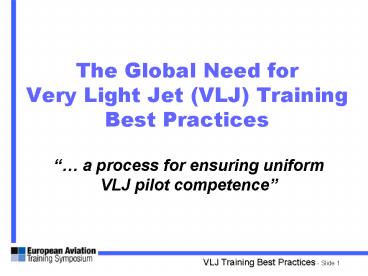The Global Need for Very Light Jet VLJ Training Best Practices - PowerPoint PPT Presentation
1 / 19
Title:
The Global Need for Very Light Jet VLJ Training Best Practices
Description:
How should the VLJ mentor fit into the regulatory process? ... For more information. Leave me your business card. or send a message to: RBarnesAZ_at_att.net ... – PowerPoint PPT presentation
Number of Views:38
Avg rating:3.0/5.0
Title: The Global Need for Very Light Jet VLJ Training Best Practices
1
The Global Need forVery Light Jet (VLJ) Training
Best Practices
- a process for ensuring uniform VLJ pilot
competence
2
What is a VLJ?
3
(No Transcript)
4
The market training opportunity
- How big is this market and what does it mean to
training providers? - The aviation community has no experience with a
new class of aircraft entering the fleet at this
pace. -- FAA Office of Accident Investigation - will place real pressure on the availability
of qualified pilots and mechanics. -- FAA
Office of Accident Investigation
5
The regulatory environment
- Many international differences in how a pilot
trains for a type rating and the related
experience requirements - Will additional training (e.g. mentoring) be
required by regulation? - Will there need to be a mentoring program
acceptable to insurers? - Consensus on training best practices is a
challenge without regulator support
6
What is needed?
- Pilot certificate is just the beginning
- Not unique to U.S. but consider
- Part 121/135 require IOE
- Part 91 does not
- A licensure-training gap exists
- Is additional regulation needed?
7
What is a standard?
- Voluntary agreements between stakeholders to
level playing field - Created through a process that develops
stakeholder consensus - Goal of VLJ training standards
- To increase the probability of safe VLJ flight
operations
8
SAE International
- Maintains over 8,300 aerospace technical
standards created by volunteer stakeholders - SAE G-10 Aerospace Behavioral Engineering
Technology Committee (ABET) produces human
factors guidance - Aerospace Recommended Practice (ARP)
- Intended as a guide toward standard practice and
can change to keep pace with industry experience
9
Who are the stakeholders?
- VLJ owner-pilots (and prospective owner-pilots)
- VLJ operators (and prospective operators) such as
air taxi and air charter businesses - VLJ mentors (and prospective mentors)
- VLJ instructor pilots (or prospective instructor
pilots) - VLJ training providers
- VLJ airframe manufacturers
- VLJ avionics manufacturers
- VLJ powerplant manufacturers
- Aviation insurers
- Aviation regulators
- Associations (e.g. NBAA, AOPA, GAMA, IUAI, etc.)
10
VLJ Training Standards Discussion Group
- Industry-wide stakeholder discussion begun in Dec
06 - Goals
- To identify key issues and concerns relating to
VLJ pilot training - To help find ways to address them
- Process
- Phase-1 Identifying a Need
- Phase-2 Consensus Building
11
Stakeholder issues and concerns
- Mentor standardization
- Role of a mentor
- Mentor qualifications
- Mentor selection
- Mentor initial training
- Mentor recurrent training
- Mentor procedures
- Determining the need for a mentor
- Defining the mentors scope-of-work for an
owner-pilot - Mentor evaluation of owner-pilots and reporting
- Mentor management (including mentor evaluation)
- Mentor liability
12
Typical discussion questions
- Should there be a standardized mentoring program
for VLJ owner-pilots? - What is the role of a VLJ mentor?
- What are the qualifications for a VLJ mentor?
- How should VLJ mentors be selected?
- How should the VLJ mentor fit into the regulatory
process?
13
Stakeholder consensus
- There needs to be some form of additional pilot
experience required beyond a type rating - This experience will probably be required by OEM
and/or insurers - This additional training should be defined by
industry standard(s)
14
An SAE International Standards invitation
- February 2007 SAE International invited the VLJ
Training Discussion Group to submit a proposal
to develop ARPs for - Qualifying and training pilots for a VLJ type
rating - Qualifying and training pilots as VLJ mentors
- Managing a VLJ mentoring program
15
SAE action August 2007
- Proposal submitted to the SAE G-10 Aerospace
Behavioral Engineering Technology (ABET)
Committee - Proposal accepted by G-10 Board
- VLJ training best practices to become focus of
G-10 Realistic Training Subcommittee
16
Current SAE focus
- Goal to define those best practices that
enhance the safety and viability of the VLJ
market - Create a foundation of experience to be used to
structure proficiency development programs - No intent to tell any manufacturer how to conduct
training or mentoring
17
Proposed scope of work
- Define the best practices by which a VLJ
post-type rating training curriculum and its
underlying performance criteria are developed - Identify the specific knowledge, skills, and
abilities needed by a VLJ mentor - Identify and recommend the best practices needed
to effectively implement and manage a VLJ
mentoring program
18
How you can participate
- SAE Standards Committee members participate as
individuals - Any person who has an interest and expertise in
the activities of a committee can request
membership - If you would like to become a member of our
Subcommittee, send me an e-mail requesting an
application
19
For more information
- Leave me your business card
- or send a message to
- RBarnesAZ_at_att.net

